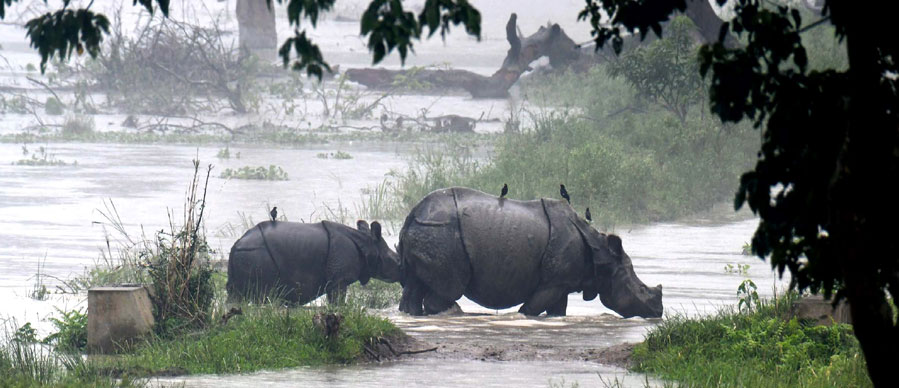Rhinos at Risk: Assam’s Pobitora Sanctuary Battles Devastating Floods
By JAGAT [06/June/2025] Assam, known for its scenic beauty and rejuvenating ambiance, often faces a grim reality during the monsoon season, when devastating floods inundate large parts of the state. This year has been no different, with nearly 60% of Pobitora wildlife sanctuary submerged under floodwaters, posing a serious threat to the endangered one-horned rhinoceros that calls this sanctuary home. The flooding began shortly after June 1, triggered by the swelling waters of the Brahmaputra and Kopili rivers, which engulfed major sections of the 16 sq km reserve. According to forest officials, the water made its way into the sanctuary via natural inlets and the Goronga Beel, significantly disrupting regular forest activities.

Among the 17 anti-poaching outposts in the sanctuary, 10 - including Dholi, Hahchora, Pagladova, and Kamarpur - have been impacted. The Dholi camp is nearly 80% submerged, making routine operations extremely challenging. Nevertheless, most of the sanctuary’s 107 rhinoceroses have instinctively migrated to elevated zones. In response to the crisis, the forest department has intensified surveillance and begun relocating elephant camps to safer locations to mitigate risk.
Just before the current flooding, Pobitora Wildlife Sanctuary recently earned acclaim for its outstanding success in conserving rhinos. For the past 11 years, the sanctuary has reported zero incidents of rhino poaching - a remarkable milestone that highlights the efficacy of its anti-poaching strategies and the essential collaboration between conservationists and local communities.
Situated within a compact core area slightly over 16 sq km, Pobitora houses more than 100 rhinos, including 27 calves. Since 2016, the absence of poaching incidents has underscored the effectiveness of rigorous protective measures and active community involvement. These efforts have been further strengthened through the introduction of the Rhino DNA Indexing System (RhoDIS), a project spearheaded by the Wildlife Institute of India. RhoDIS aims to build a comprehensive genetic database of rhinos in sanctuaries like Pobitora to enhance identification and legal action against poachers. Nevertheless, conservationists remain concerned about persistent issues such as inbreeding risks and potential disease transmission from nearby domesticated animals.
During the ongoing tourist season, approximately 23,000 people have visited Pobitora, leading to a 15% surge in revenue compared to previous years. The sanctuary offers a variety of experiences, including jeep and elephant safaris, with future plans to introduce boat safaris contingent on favorable weather conditions.
Though floodwaters have spread across much of the sanctuary, the rhinos are largely out of danger. Many have migrated to the elevated areas within the sanctuary, while others are still occupying patches of grassland that remain above the flood level. Forest authorities are maintaining constant vigilance over their movements. Using a combination of country boats and mechanized patrol vehicles, guards are actively monitoring the wildlife. Half of Pobitora’s elephant population has also been moved to safer ground, primarily in the Burha Mayong region, with additional relocations expected soon.
Forest personnel remain on full alert, navigating the submerged terrain daily to continue their monitoring efforts. Anti-poaching patrols persist without interruption, and the department has affirmed its readiness to manage emergencies. “We are fully prepared to face any challenge the floods may bring,” stated Ranger Baruah. Despite its modest size, Pobitora holds immense importance at the national level, boasting the highest density of one-horned rhinoceroses in India. However, the ongoing flood situation has heightened concern among conservationists. With such a high concentration of animals in a confined area, there is growing apprehension about their safety and overall health.

 +91-9354066284
+91-9354066284  info@pobitorawildlifesanctuary.in
info@pobitorawildlifesanctuary.in

